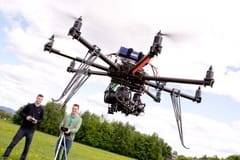
Introduction:
In the second installment of our series on drones, we analyzed a recent opinion in the United States Court of Appeals for the District of Columbia Circuit regarding a verdict that will affect the legality of registering your drones. As we learned last time, owners of recreational “model aircraft” are not obligated to register with the FAA nor are they subject to civil fines or imprisonment for not doing so as it is a violation of 336(a) of the FAA Modernization Act.
Civil Liability Claims (Invasion of Privacy):
Before you head to the beach this weekend with your drone to take some pictures or Facebook Live the video feed from your drone, here are some things to ponder. Due to the increased usage of drones by private citizens, a civil tort action is likely to arise from an invasion of privacy claim. Since cameras are being fixed to most drones now, operators are sometimes unaware they are taking photos while operating the drone. This mistake can lead to lawsuits.
Privacy has been a major issue in the United States for the past century. The right to privacy and air space was addressed by the Supreme Court in United States v. Causby, a takings clause case arising out of an invasion of privacy claim. In Causby, the Court explained that “while the owner does not in any physical manner occupy that stratum or airspace or make use of it in the conventional sense, he does use it in somewhat the same sense that space left between building for the purpose of light and air is used.” Thus, landowners have some privacy rights to the lower altitudes of their homes, such as spaces at eye level and that are under the exclusive control of the landowner.
In Texas, three potential civil claims for invasion of privacy can arise (1) unreasonable intrusion upon the seclusion or private affairs of an individual, (2) unreasonable publicity to an aspect of the private life of an individual when the public has no legitimate concern, and (3) unwarranted appropriation of one’s name or likeness.
In addition to the criminal penalties discussed in our first installment on drones, the Texas Privacy Act also establishes civil liability for drone misuse by operators in violation of the act. Tort liability under sections 423.003 and 423.004 starts at $5,000 for an illegally captured image for one violation and will increase to $10,000 for disclosure of that image. The statute holds a 2 year statute of limitations for claims made from either the date of the illegally captured image or the unlawful disclosure of the image. Under the act a Plaintiff can recover (1) actual damages for malicious distribution of images taken while operating their drone, and (2) attorney fees and court costs associated with the litigation. In order for a Defendant to help his defense he should immediately check his drone camera after each use and delete any images he was not supposed to take. If you do take any pictures make sure you get express permission to use the image if you intend on disclosing it on the internet or other public space.
Key Take-Aways:
(1) All drone operators should be mindful when capturing images with their drones, and if they do not have permission, should destroy all images captured; and
(2) Live streaming of video from your drone will likely invite a lawsuit when you capture images or video of something you were not supposed to see, i.e., the employee caught surfing at the beach while he is supposed to be at home sick from work when his boss sees your video.
So go enjoy the beach this weekend, but leave the drone at home.
See United States v. Causby, 328 U.S. 256 (1946).
Id. at 265.
See Billings v. Atkinson, 489 S.W.2d 858, 860 (Tex. 1973).
See TEX. GOV’T CODE ANN. Sect. 423.006
See id. Sect. 423.006(a).
See id. Sect. 423.006(a)(3).
See id. Sect. 423.006(d)

